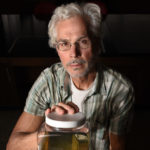By Gary Hengstler | Photos by Angela Foster / UT Chattanooga
Four researchers at the University of Tennessee at Chattanooga could hardly be more conscious of streams. And what flows through them.
They also are faculty in the biology, geology and environmental sciences department at UT Chattanooga, and their ecology studies of Tennessee water quality often cover similar issues, even as each has carved out his own special niche to attack specialized problems.
John Tucker, the department head, helps Chattanooga comply with federal regulations on stormwater runoff and ways to lessen the amount of pollution making its way to Tennessee’s streams. That’s no small task, considering stormwater is the nation’s biggest source of water pollution, according to Tucker.
Mark Schorr and his graduate students have documented effects of human disturbances, including industrial development, dams and rechanneling flow on stream-water quality at more than 100 sites in the Chattanooga area. Currently, he is measuring the effects of mitigation efforts to undo decades of damage to polluted streams in Chattanooga’s urbanized watersheds.
Sean Richards monitors the increasing amount of pharmaceuticals in rivers and streams. Because treatment plants don’t have filters to block drugs, pharmaceuticals go into the surface waters still retaining powerful ingredients after humans expel them.
For example, Richards studied water samples from Knoxville to Chattanooga. He found caffeine 95 percent of the time. He also found the antibiotic Ciprofloxacin—more commonly known as Cipro—and antidepressant and antianxiety drug Prozac. In searching for 13 different drug molecules, he found them all.
Tom Wilson’s passion for amphibians and reptiles led him to study salamanders and turtles and the effect decreasing water quality has on them. “We are using them as a mechanism for our own habitat research,” he says.
Many factors impact streams, but all four scientists agree on one conclusion: Water quality is deteriorating.
Schorr cautions that water quality refers to selected physical chemistry and biological characteristics of water, in which data are compared to standards for protecting human health and aquatic life.
“A lot of the research I’ve done at UTC has examined relationships between different levels of watershed urbanization and how that affects the environment in the stream and the organisms living in the stream.”
Characterized by hard, impervious surfaces such as roads and parking lots, urban watersheds deliver large quantities of stormwater runoff and pollutants to streams. Research by Schorr and his students shows that urban land use in Chattanooga-area watersheds has created negative effects in streams through higher temperatures, nutrient levels and sediment along with lower oxygen concentrations.
Dig Deeper into the Research
Learn more about each UTC researcher and their work and the links below:

Water is Future
Multi-faceted and entangled issues of water quality, environment and now increasingly the law have implications for Tennessee’s future. They certainly have John Tucker’s attention.

Possible Side Effects
Ever wondered how those Tylenol tablets taken for the occasional headache will eventually affect some fish? Sean Richards has.

Quality of Life
Mark Schorr researches stream fish ecology, with an emphasis on water pollution issues and population/community ecology.

A Sixth Mass Extinction
Thomas Wilson researches the adverse effects of deteriorating water quality and habitat on amphibians and other aquatic life in the area.
It isn’t just about pollutants such as lawn fertilizer, animal feces, oil and metals from car exhausts and other pollutants. It’s also about the quantity.
Richards warns, “In a lot of places where we are drawing water out, you’re increasing the concentration of the pharmaceuticals.” That also applies to other elements—fertilizer, nutrients, pollutants—where a stream’s ability to handle them fades when water is diminished, making toxic elements more concentrated.
But just as too little water can harm the stream and the life it supports, too much water creates its own woes. Schorr says that, decades ago, the natural channels of many urban streams were altered—straightened—and lined with concrete to prevent flooding.
Shooting the water quickly through the stream, however, “is a huge insult to the stream and involves an extreme degradation. Moreover, it just pushes the flooding down to somewhere else,” he says.
“Water is one thing that ties it all together—one unifying theme of life is all tied to water,” Wilson says. “The growth of urbanization and economic development has left its mark with water pollution.”
There are no quick fixes. Wilson looks at photos of salamanders with skins marked by lesions from chytrid fungus, a virulent pathogen causing amphibian death and population decline. He also recalls a student who was surprised to find the pesticide DDT in the blood of a turtle. “I asked him why he thought it was strange, and he said, it’s because we’re not producing DDT anymore.
“I said that’s true, but DDT degrades slowly as compared to some others, and turtles pick it up in water quality impurities and also in what they eat.”
Wilson foresees that, “If you look at all the major events that happened since the dawn of time, there is a large amount of evidence that we are living in the time of the sixth mass extinction: amphibians.”
None of the specialists describe an optimistic future for addressing water issues. Richards’ emphasis to his students has shifted to the effect of water quality on their health and the economy.
“Look at the BP oil spill from 2010. There are a lot of environmentalists on the Gulf Coast now because their oyster beds are affected, redfish stock is being depleted or shrimp are becoming inedible,” he says. “People turn the page pretty quickly when they are impacted. Unfortunately, I feel like a lot of people have yet to get to that point. And, at that point, it’s too late.”
Schorr poses the stark reality: “In our lifetime, our children’s lifetime and our grandchildren’s lifetime, it’s a fallacy to believe streams will clean themselves. We’re not going to stop development and restore streams to their pristine condition.”
Wilson says, “The true problem is that, when you have conservation-related issues, you have all these different players—industry, governance, private sector, general public, educators, researchers, practitioners and consultants. The biggest challenge is to get everyone on the same page.
“When you start putting profits before safety, you cheat yourself and your children’s future. That’s the sad thing because you’d like to have people understand their connections to all. Again, water ties it all together.”
But that does not mean they have stopped trying. A look around the Chattanooga campus proves it.
“When you look at the parking lots here, you may not realize that some lots include stormwater treatment,” Tucker says. “You have large gravel along the edges, then plants, so these gravel areas slow water down and retain pollutants.”



